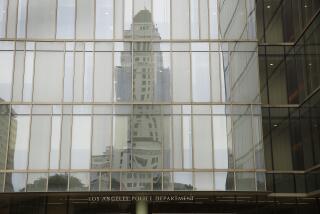Slain L.A. athlete mistaken for a gang member, prosecutor says
- Share via
The 17-year-old football star’s skin was black and his backpack red.
Were it not for those colors, a prosecutor told jurors Tuesday, Jamiel Shaw II might never have been murdered by an 18th Street gang member eager to earn his stripes.
Deputy Dist. Atty. Allyson Ostrowski said Pedro Espinoza, now 23, shot Shaw execution-style in 2008 thinking he was a Bloods gang member because he was African American and was carrying a red Spider-Man backpack.
Shaw, who played for Los Angeles High School, was killed in March of that year just a few houses away from his Arlington Heights home. His father heard the gunshots and ran out to find his son bleeding on the pavement.
Shaw was on his cellphone talking to his girlfriend, who testified that she heard a voice ask, “Where are you from?” before the phone went dead.
In closing arguments Tuesday capping a weeklong trial, Ostrowski alleged that the voice belonged to Espinoza, who just 28 hours earlier had been released after serving time for an earlier gang-related incident in which he threatened a man with a gun. Espinoza belonged to a clique that constituted the “most violent of the most violent” among 18th Street gang members, she said.
In addition to numerous 18th Street tattoos, Espinoza had “BK” — standing for “Blood Killer” — inked on the side of his neck, the prosecutor told jurors.
When Espinoza saw Shaw’s backpack, Ostrowski said, he took him to be a member of the Rollin 20’s Bloods. And before Shaw could respond to his question, he shot the athlete in the stomach, then walked around his body and fired a second round into his head, Ostrowski told jurors.
“That second shot to Jamiel’s head, that’s an execution, that’s a demonstration of this defendant’s intent to kill,” she said.
Espinoza faces a first-degree murder charge, with allegations that he was acting in association with a criminal street gang. He is not accused of a hate crime. Prosecutors are seeking the death penalty.
Ostrowski cited the testimony of a young woman who said Espinoza and a second gang member were in her car when they spotted Shaw. Espinoza jumped out, saying, “I’ll be right back.” After shots were fired, he got back in the car, and the other gang member remarked: “Damn ... you a killer,” according to the woman’s testimony.
“Yeah, I’m a killer, like ‘Kid,’ ” she said Espinoza responded as they drove away, referring to a notorious 18th Streeter who was behind a mass shooting of rival gang members and police.
The statement, the prosecutor contended, was “adoptive admission” that he had in fact murdered Shaw.
Espinoza’s attorney, Csaba Palfi, emphasized for jurors inconsistencies among witnesses’ accounts and the prosecution’s failure to produce a murder weapon. An eyewitness testified that the shooter wore a black hooded sweat shirt, while two others who saw Espinoza around the same time said he was wearing a light-colored T-shirt, Palfi said.
He also said that if his client was guilty of the shooting, he would not have reported to his probation officer and registered as a gang member in the days immediately after the incident.
“Does a guilty man walk into the lion’s den?” Palfi said.
For Shaw, a running back who was being courted by Stanford and Rutgers, the shooting came at the end of a typical teenage boy’s day. After football practice, he took the bus to the Beverly Center with a friend. On the way back, they ate at Chipotle, flirted with some girls and ran late because they got on the wrong bus.
His mother, Army Sgt. Anita Shaw, watched from the audience in full uniform as photos of the bloody scene were projected onto a large screen. Her son was a fun-loving teenager who would playfully sit on her lap even though he towered a head taller than she did, she recalled.
“We kept waiting for him to come through the door, like it was a bad dream,” she said outside court. “Now, we’re just there like zombies in the house.”
More to Read
Sign up for Essential California
The most important California stories and recommendations in your inbox every morning.
You may occasionally receive promotional content from the Los Angeles Times.











